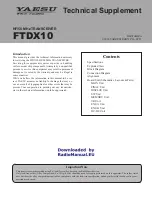
106
• Hot Standby RTK Algorithms
• Flying RTK Algorithms
• RTK base and rovers modes, post-processing mode
• Moving base
– RTK with Static & Moving Base corrections supported
–
Multi-dynamic mode (static/moving Base and Rover
functions simultaneously)
– RTK against a moving base for relative positioning
• Heading and Roll/Pitch
– Accurate and fast heading using dual-frequency,
multi-GNSS algorithms
–
RTK or Trimble RTX and heading processing
simultaneously
– Heading engine with optional baseline length self-
calibration
–
Adaptive velocity filter to meet specific dynamic
applications
• Adaptive velocity filter to meet specific dynamic
applications.
• Up to 50 Hz real-time raw data (code & carrier and
position, velocity, and heading output)
(4)
• Reference Inputs/Outputs: RTCM 3.2
(5)
, RTCM 3.1/3.0/
2.3/2.1, CMR/CMR+, ATOM
(6)
• Supported RTK networks: VRS, FKP, MAC
• NTRIP protocol
• Navigation outputs: NMEA-0183, ATOM
• PPS output
• Event marker input
• One-push Ashtech Trouble Log (ATL)
GNSS Sensor Performance
• Time to First Fix (TTFF):
–
Cold start: < 60 seconds
–
Warm Start: < 45 seconds
–
Hot Start: < 11 seconds
–
Signal re-acquisition: < 2 seconds
• Position accuracy (HRMS), SBAS: < 50 cm (1.64 ft)
(7)
• Update rate: Up to 50 Hz
(4)
• Latency: < 10 ms
(8)
• Velocity Accuracy: 0.02 m/sec HRMS
















































